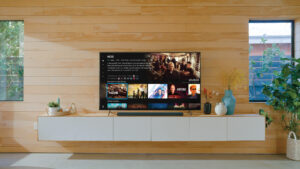
After more than 40 years of operation, DTVE is closing its doors and our website will no longer be updated daily. Thank you for all of your support.
Smart TV – the case for an independent OS
 With streaming now the primary mode of video consumption, the smart TV has come of age, enabling TV manufacturers to compete with service providers and other device suppliers as providers of gateways to entertainment.
With streaming now the primary mode of video consumption, the smart TV has come of age, enabling TV manufacturers to compete with service providers and other device suppliers as providers of gateways to entertainment.
The advent of smart TV as perhaps the fastest growing category of device as an enabler of entertainment in the home means that the business of differentiating one TV brand from another at the point of sale increasingly leans on the user experience and user interface associated with smart TV functionality as much or more than the quality of the screen, image resolution and sound quality.
But not all smart TV manufacturers are equal. The power and scale of one or two CE giants means that a large number of other OEMs are in danger of being squeezed out. Building a smart TV ecosystem is not a trivial enterprise.
OEMs face a stark choice: take on the heavy costs of developing, maintaining and provisioning their own smart TV operating system or teaming up with one of a small group of smart TV OS providers who may set limits on their freedom to commercialise the platform as they see fit, and prioritise their own channels while limiting the discoverability of other content.
Independent Media Platform
Step forward TiVo OS. The independent media platform from Xperi-owned video technology brand TiVo that delivers the benefits of smart TV to OEMs without setting limits or restrictions on how they can commercialise their services.
“A conviction that there is a significant gap in the market for an independent smart TV OS has been central to Xperi’s entry into the space,” says Gabriel Cosgrave, general manager EMEA at Xperi. “OEMs need and want an OS that does not dilute their brand and provides a ‘content-centric UX’.”
Xperi’s TiVo, better known as a platform for TV service providers than for TV manufacturers, is now providing what Cosgrave describes as “an independent media platform” for OEMs that gives them more control over their own brand, deploying smart screens that are ‘Powered by TiVo’ rather than owned by TiVo, giving more prominence to the manufacturer’s brand.
“TiVo is a powerful brand but the manufacturers want to promote their own products so we bring the two together,” says Cosgrave. However, the brand “on the box and on the home screen” is that of the OEM.
Universal discovery
Key to what Cosgrave describes as TiVo’s “content-centric” approach is universal search and recommendation, contrasted with scenarios where search capabilities sit exclusively within apps.
“With most smart TV ecosystems you have exactly the same look and feel across TV brands and it’s very difficult to differentiate, but you also typically have a sea of apps and have to open each individual streaming service to find out what content it has – the search capabilities are within the apps,” says Cosgrave.
“We purposely designed a content-centric user experience from day one – something we have been doing for many years with search and recommendation – meaning you are searching for content, no matter where it comes from. You don’t need to open and close apps, so from a consumer’s perspective the time to find content is shorter. There is an AI enabled recommendation engine that plays a powerful role in being able to surface more content that people like to watch without them having to figure out where everything sits.”
Being able to surface the right content at the right time requires both strength and depth of metadata: deep-linked metadata and breadth of metadata assets and tags. For its part, TiVo’s own video metadata products, which includes TMDb, provide tens of millions of metadata assets that enable search for content and for things within content such as, for example, well-known phrases associated with movies and individual series episodes.
Cosgrave believes that the advantages this offers are increasingly key to differentiation in the TV manufacturing space. As TVs across brands become more and more alike in terms of their technical specifications, marketing to consumers is likely to focus more around the UX and discovery, including using voice. Being able to build individual user profiles that can deliver contextually relevant recommendations is an important battleground in the emerging competitive landscape.
“Given the amount of time people spend – or waste – trying to find content, I think this is going to be a big game changer for consumers and TV manufacturers alike,” he says.
Recurring revenues
In addition to brand independence, the tier of OEMs that do not quite have enough market recognition or power to launch and maintain their own smart TV ecosystem are also seeking to offer services based on a viable business case around advertising.
The advertising pie associated with connected TV is becoming more attractive in part because consumers are becoming more accustomed to the benefits of an implicit contract whereby they pay less (or nothing) for video content in exchange for being presented with in-content advertising.
TiVo generates revenues through its ad sales business and end-to-end ad technology stack, which enables it to run programmatic ads, banner ads and other types of campaign over the platform. In a world of wafer-thin margins on screens, such recurring revenues are highly attractive to OEMs.
“We made a decision early on to share our advertising revenue with the TV OEMs themselves, which can bring them a whole new set of recurring revenue streams,” says Cosgrave.
Advertising inventory to be monetised through the revenue share model includes, primarily, advertising inserted into the content made available through the platform as well as additional inventory around the UX.
“The largest and most lucrative part is advertising in the content, although of course we do display advertising and banners,” says Cosgrave.
In addition to enabling advertising, TiVo is also able to share its wealth of subscriber usage data with the TV manufacturers.
“Availability of data has been controlled by the tech giants for many years, but we are in a position to help share that with the OEMs. So there are quite a few areas that make our business model very attractive to those companies,” says Cosgrave.
Content relationships
 Those advantages are likely to be all the more attractive to OEMs fighting to secure a place in a market characterised by cut-throat competition.
Those advantages are likely to be all the more attractive to OEMs fighting to secure a place in a market characterised by cut-throat competition.
But small and medium-sized players are not only struggling with intensive price competition. They are also being squeezed out in the battle to strike partnerships with suppliers of the most attractive content, all of whom are looking for scale when it comes to doing deals.
Cosgrave points out that Xperi can help here thanks to the content studio relationships the company has built up over many years to support its DTS audio and TiVo brands. TiVo, for example, is present in around 50 million households globally through the company’s pay TV agreements, while DTS is in over 100 million devices globally.
“We’re very well-positioned to help OEMs source those content partners, as well as streaming service partners that they not be able to get access to otherwise,” he says.
Large content companies typically certify their content licences on a platform-by-platform basis. Xperi, via DTS and TiVo, has relationships not only with the studios but with the vast majority of chipset suppliers, enabling it to “hit every end of the ecosystem” and secure certifications on behalf of its OEMs, says Cosgrave.
With over 1,200 engineers within Xperi and strength in depth in advertising and regulatory expertise that spans the global marketplace, the company is well-placed to help TV manufacturers deliver a compelling – and differentiated – experience and the ability to monetise it through recurring advertising-based revenue streams. As competition in the TV manufacturing space shows no sign of becoming less intensive, the kind of help this provides to players outside the charmed circle of a handful of consumer electronics giants could be crucial in defining the line between success or failure.
This is sponsored content.

